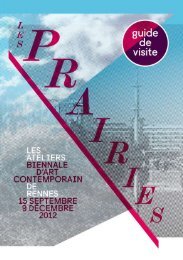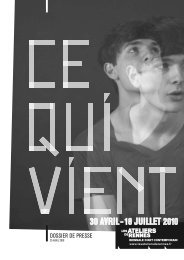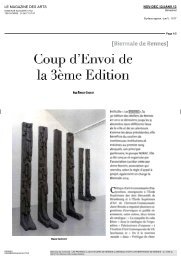Download here the Visitor's guide. - Les Ateliers de Rennes
Download here the Visitor's guide. - Les Ateliers de Rennes
Download here the Visitor's guide. - Les Ateliers de Rennes
Create successful ePaper yourself
Turn your PDF publications into a flip-book with our unique Google optimized e-Paper software.
46<br />
<strong>Les</strong> Prairies's artists<br />
FLORIAN FOUCHé<br />
L’école du village, Musée du paysan roumain, Bucarest, 2010-2012. Courtesy of <strong>the</strong> artist.<br />
In 2007, Florian Fouché went to Târgu Jiu in Romania to study <strong>the</strong> war memorial<br />
erected t<strong>here</strong> by Brancusi in 1938. The ensemble comprises three sculptures: <strong>the</strong> Table<br />
of Silence, <strong>the</strong> Gate of <strong>the</strong> Kiss and <strong>the</strong> Column of <strong>the</strong> Infinite. It is a con<strong>de</strong>nsation<br />
of formal vocabulary that links <strong>the</strong> pared down simplicity of his plan to archaism.<br />
Fouché evi<strong>de</strong>ntly found <strong>the</strong> same balance at <strong>the</strong> Museum of <strong>the</strong> Romanian Peasant<br />
in Bucharest, which was refurbished in 1990 un<strong>de</strong>r <strong>the</strong> direction of <strong>the</strong> painter Horia<br />
Bernea, whose anthropologist fa<strong>the</strong>r was a specialist in peasant culture. On <strong>the</strong> <strong>the</strong>ory<br />
that sympa<strong>the</strong>tic organisation of <strong>the</strong> objects could act as explanation in itself, Bernea<br />
and his team transformed obsessive didacticism into a gently pedagogic approach<br />
that <strong>the</strong>y hoped would give rise to a "poetics of museography". Out of context, <strong>the</strong><br />
vernacular objects are ren<strong>de</strong>red exotic by <strong>the</strong> occasionally somewhat Mo<strong>de</strong>rnist<br />
<strong>de</strong>vices used to exhibit <strong>the</strong>m – pe<strong>de</strong>stals, cabinets, mannequins, hanging rails. In 2010<br />
Florian Fouché took photographs of some of <strong>the</strong>se arrangements. Twenty-eight of <strong>the</strong><br />
one hundred and twenty images are presented <strong>here</strong> between glass plates, on shelves.<br />
With its sensitive treatment of fragmentary views, exploiting <strong>de</strong>pth and transparency,<br />
<strong>the</strong> arrangement is partly inspired by <strong>the</strong> display cabinets <strong>de</strong>signed by Bernea. For<br />
<strong>the</strong> <strong>Ateliers</strong> <strong>de</strong> <strong>Rennes</strong> Florian Fouché continued his research, in <strong>the</strong> summer of 2012,<br />
with <strong>the</strong> team at <strong>the</strong> museum. He is writing about this extraordinary ensemble whose<br />
experiments in scenography tally in some respects with <strong>the</strong> intuitive syncretism of his<br />
own approach.<br />
H. M. tr. J.H.<br />
Born in 1983 in Lyon, lives and works in Paris (France).<br />
Production<br />
<strong>Les</strong> <strong>Ateliers</strong> <strong>de</strong> <strong>Rennes</strong> 2012.






